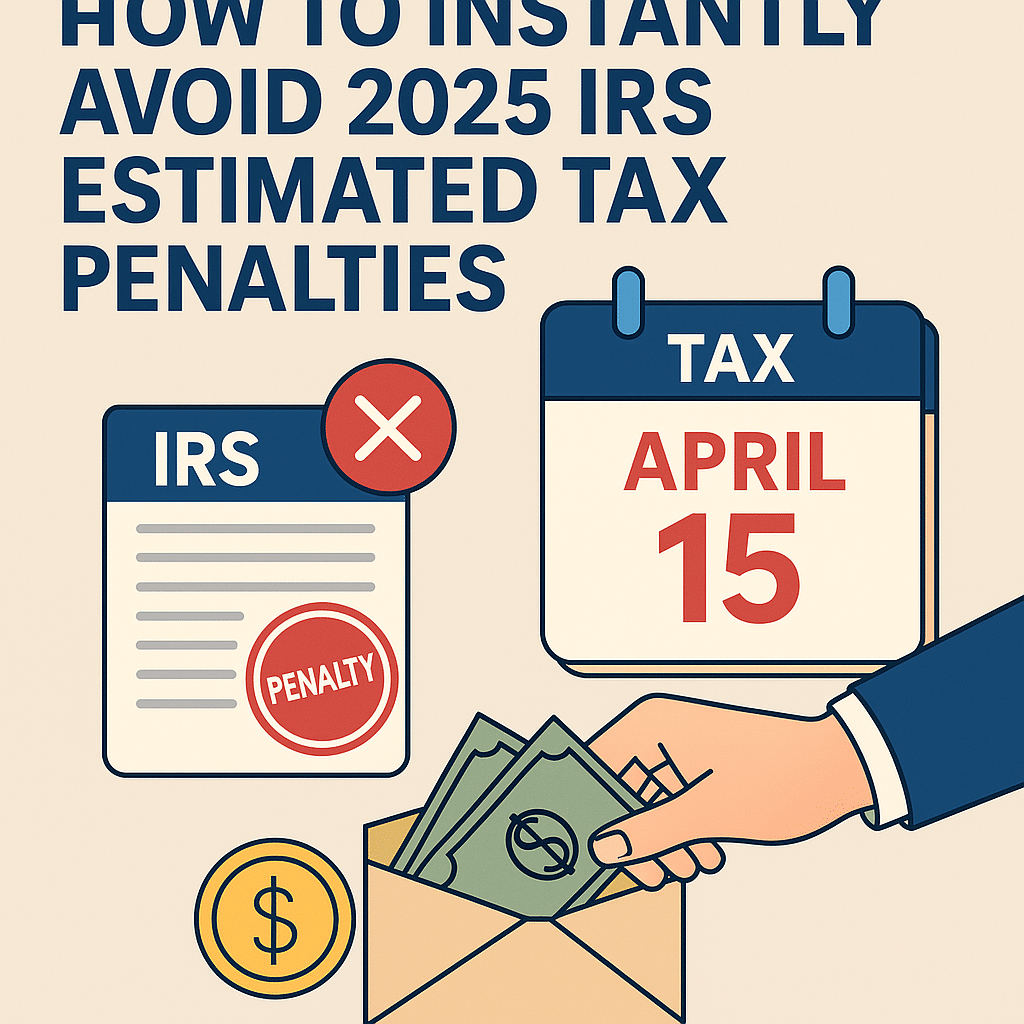Many self-employed professionals and business owners are surprised to learn they can owe hundreds—or even thousands—of dollars in IRS underpayment penalties simply because their estimated tax payments weren’t made on time. The good news? With the right strategy, you can stop those penalties from growing—or even eliminate them entirely.
Why the IRS Requires Quarterly Estimated Payments
The U.S. income tax system operates on a “pay-as-you-go” basis. That means you must pay taxes as you earn income, rather than waiting until you file your return. Employees meet this obligation through withholding on each paycheck. But if you’re self-employed, own a pass-through business, or receive significant investment or rental income, you must generally pay your own taxes quarterly using estimated payments.
Quarterly due dates are:
• April 15 – income earned January 1 – March 31
• June 15 – income earned April 1 – May 31
• September 15 – income earned June 1 – August 31
• January 15 of the following year – income earned September 1 – December 31
Missing or underpaying any of these installments usually results in a penalty for that specific period, even if your total tax bill is paid in full later.
IRS: Estimated Taxes Explained
Why Payments Must Be Ratably Made
Estimated tax isn’t just about how much you pay—it’s also about when you pay it. The IRS expects payments to be ratable, or spread fairly evenly over the four quarters. Paying a large lump sum at year-end doesn’t erase earlier shortfalls because the penalty is calculated quarter by quarter.
Each underpaid period accrues interest separately. A single year-end payment cannot retroactively satisfy missed installments. Even if your year-end balance is zero, you may still owe penalties for late quarters.
This structure ensures taxpayers stay current throughout the year and prevents cash-flow shocks at filing time.
IRS Form 2210 Instructions: Underpayment of Estimated Tax
The Problem: Falling Behind on Estimated Taxes
Suppose you planned to make $25,000 quarterly payments toward your 2025 taxes but haven’t sent any by October 1. If you do nothing, you’ll likely face about a 7 percent non-deductible penalty on those unpaid amounts—compounded daily. Because the penalty isn’t deductible, the effective cost can approach 10 percent after taxes.
IRS: Estimated Tax Penalty Overview
Why Sending a Payment Now Doesn’t Fix the Past
A payment made today will stop penalties from increasing going forward, but it won’t erase those already accrued for previous quarters. To remove the penalty entirely, you need a method that the IRS recognizes as if the taxes had been paid evenly all year.
If you’re unsure how to structure your payment plan or projections, our team can help. Learn more about Reckenen’s Tax Planning and Advisory Services.
The 60-Day IRA Rollover Strategy
If you have a retirement plan that allows a 60-day rollover, there’s a legitimate way to make those penalties disappear.
Example:
You owe $100,000 in estimated taxes for the year but missed the first three installments. You can:
- Withdraw $100,000 from your IRA or other eligible plan.
- Ask the custodian to withhold the full $100,000 for federal income taxes and send it to the IRS.
- Within 60 days, repay the same $100,000 back into your IRA from another account.
Result:
The IRS counts the withheld amount as if it were paid evenly across all four estimated tax due dates. Because you replaced the funds within 60 days, the withdrawal isn’t taxable and no early-distribution penalty applies.
IRS Publication 590-A: Contributions to IRAs
IRC § 408(d)(3): 60-Day Rollover Rules
Eligible Accounts
This method works with: Traditional IRA, Roth IRA, SEP IRA, SIMPLE IRA, 401(k), 403(b), and 457(b).
For IRAs, the one-year rule limits you to a single 60-day rollover within any 12-month period across all IRAs combined.
IRS: One-Rollover-per-Year Rule
There’s no such limit for employer-sponsored plans such as 401(k)s or 403(b)s.
Using RMD Withholding if You’re Age 73 or Older
Taxpayers aged 73 or above must take required minimum distributions (RMDs) from retirement accounts each year.
By electing federal income-tax withholding from your RMD, you can simultaneously:
• Satisfy your annual RMD obligation, and
• Apply that withholding toward estimated tax requirements, reducing or eliminating penalties.
IRS Publication 590-B: Distributions from IRAs (RMD Rules)
If you need assistance planning RMDs or structuring retirement-related tax withholding, Reckenen’s CFO and Financial Advisory Services can help you align tax strategy with cash flow management.
The Costly Alternative: Paying Yourself a “Bonus”
Some S-corporation owners try to catch up on missed estimates by paying themselves a large year-end bonus and withholding all taxes from it. That’s almost always the wrong move because:
- Payroll taxes (Social Security and Medicare) apply—about 15.3 percent combined.
IRS Publication 15: Employer’s Tax Guide (FICA Rates) - The bonus reduces qualified business income (QBI), potentially lowering your Section 199A 20 percent deduction.
IRS: Qualified Business Income Deduction
In most cases, these extra taxes cost far more than the original underpayment penalty.
Key Takeaways
• Estimated taxes are required because the U.S. tax system is pay-as-you-go—taxes must be paid as income is earned, not just at filing.
• Payments must be ratable (made in roughly equal installments) to avoid penalties for each underpaid quarter.
• The 60-day IRA rollover strategy can eliminate estimated-tax penalties if executed and repaid within the allowed window.
• Retirees aged 73 and older can use RMD withholding to meet or catch up on estimated tax obligations efficiently.
• Avoid relying on year-end payroll “bonuses” to make up missed payments—they trigger payroll taxes and may reduce your Section 199A deduction.
• Always consult a CPA or qualified tax advisor to ensure proper timing, documentation, and compliance before implementing any of these strategies.
Legal Disclaimer
This material is for informational purposes only and should not be construed as tax or legal advice. Circumstances vary, and you should consult your CPA or financial advisor before taking any action based on this information.

